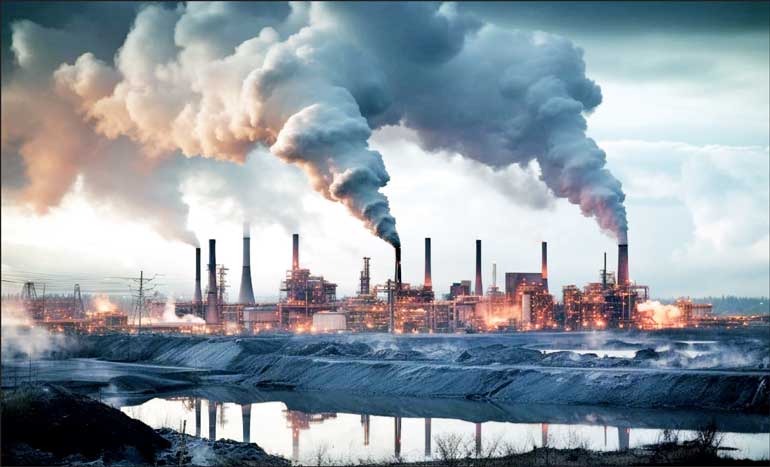Friday Dec 19, 2025
Friday Dec 19, 2025
Saturday, 26 August 2023 00:40 - - {{hitsCtrl.values.hits}}
 Global and regional collaboration through carbon trading could help countries such as Sri Lanka to scale up climate action and sustainable development
Global and regional collaboration through carbon trading could help countries such as Sri Lanka to scale up climate action and sustainable development
For countries such as Sri Lanka, carbon trading can present an important opportunity to collaborate with other countries through bilateral agreements, such as, the memorandum with Singapore, or by engaging in voluntary as well as UN-regulated carbon markets. Carbon trading can help the country to leverage its own decarbonisation activities and mobilise finance, investment, and technology to become more resilient and develop its economy along green, clean, and sustainable pathways
 If the worst impacts of climate change are to be avoided, countries around the world need to urgently reduce their greenhouse gas (GHG) emissions and engage in ambitious mitigation action. To achieve this, global and regional collaboration would be pivotal to scale up climate action, harness synergies, and achieve deeper decarbonisation as well as sustainable development within this decade.
If the worst impacts of climate change are to be avoided, countries around the world need to urgently reduce their greenhouse gas (GHG) emissions and engage in ambitious mitigation action. To achieve this, global and regional collaboration would be pivotal to scale up climate action, harness synergies, and achieve deeper decarbonisation as well as sustainable development within this decade.
Sri Lanka signed a Memorandum of Understanding with Singapore on 22 August, in the presence of President Ranil Wickremesinghe and the Prime Minister of Singapore, Lee Hsien Loong. This memorandum focuses on collaboration between the two countries on carbon credits in the context of Article 6 of the Paris Agreement, which is an area of the global climate change framework that has been subject to complex negotiations over the past years.
Implementing Article 6 is considered to unlock a more cost-effective way to achieve national targets for the reduction of GHG emissions, mainly through the trade of carbon credits. A report by the International Emissions Trading Association (IETA) suggests that carbon trading has the potential to cut the costs of implementing Nationally Determined Contributions (NDCs) by more than 50% by year 2030. But what exactly is Article 6, and how does it work?
Carbon trading and a global carbon marketplace
Article 6 of the Paris Agreement covers bilateral carbon trading as well as carbon markets, which would allow parties to the Paris Agreement to trade carbon credits. These credits, also called “internationally transferred mitigation outcomes” (ITMOs), are created by reducing GHG emissions or removing them from the atmosphere; for example, by shifting to renewable energy sources such as solar or wind, or by restoring degraded forest ecosystems.
As contained in the Paris Agreement, Article 6 comprises nine paragraphs that outline how parties can “pursue voluntary cooperation” to reach their climate targets. Three of these paragraphs in particular, serve to illustrate the main areas of carbon trading:
Article 6.2 provides the basis for the voluntary trading of ITMOs (i.e., the reduction of GHG emissions) directly between countries, which can be measured in carbon dioxide equivalent (CO2e) or other metrics such as kilowatt-hours of renewable energy. Voluntary trading can help countries in two ways: they can mobilise much-needed finance by selling carbon credits, and they can buy carbon credits to help them achieve their climate targets under the Paris Agreement. At present, there are pilot schemes for trading Article 6.2 ITMOs that involve countries such as Canada, Germany, Japan, Norway, Sweden, or Switzerland buying ITMOs from developing countries across Asia, Africa, and South America.
Article 6.4 is supposed to create a mechanism supervised by the United Nations Framework Convention on Climate Change (UNFCCC), specifically, a yet-to-be-established “Article 6.4 Supervisory Body,” and allows countries to trade their emission reductions on a global compliance marketplace. These carbon credits (sometimes called “A6.4ERs”) would be UN-recognised and entered in a centralised registry, providing an added layer of accountability, integrity, and quality assurance.
Finally, Article 6.8 covers “non-market approaches” that promote mitigation and adaptation, without directly trading emissions, such as, cooperation on finance, technology transfer, and capacity-building between countries.
There are some key principles that need to be ensured when it comes to carbon trading under Article 6. First, carbon credits or ITMOs can only count towards one country’s NDCs, and it is important to avoid double-counting, primarily through an accounting mechanism known as “corresponding adjustment.” Furthermore, 2% of all credits under Article 6.4 will be cancelled without anyone using them (to go beyond the mere offsetting of emissions), and 5% of all credits will be given to the Adaptation Fund to generate additional finance for adaptation.
Article 6 and voluntary carbon trading
As the Article 6 “rulebook,” a package of rules to govern and implement international carbon market mechanisms has been approved at COP26 in Glasgow at the end of 2021, only trading under Article 6.2 takes place currently. However, there is also carbon trading outside the purview of Article 6 on the “voluntary carbon market” (VCM), which is mostly driven by the private sector and large multinational corporations.
Over the last years, VCM has been an important source of climate finance for developing countries. However, it is not backed by the UN and does not have the same integration with the Paris Agreement commitments and counting mechanisms. Once Article 6.4 is fully operationalised, it remains to be seen how the VCM will develop and if it could still be leveraged to support developing countries in their efforts towards climate action and sustainable development.
For countries such as Sri Lanka, carbon trading can present an important opportunity to collaborate with other countries through bilateral agreements, such as, the memorandum with Singapore, or by engaging in voluntary as well as UN-regulated carbon markets. Carbon trading can help the country to leverage its own decarbonisation activities and mobilise finance, investment, and technology to become more resilient and develop its economy along green, clean, and sustainable pathways.
(The writer works as Director, Research & Knowledge Management at SLYCAN Trust, a non-profit think tank based in Sri Lanka. His work focuses on climate change, adaptation, resilience, ecosystem conservation, just transition, human mobility, and a range of related issues. He holds a Master’s degree in Education from the University of Cologne, Germany and is a regular writer to several international and local media outlets.)